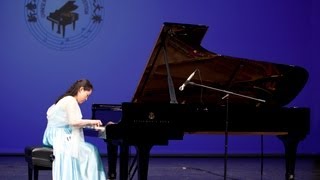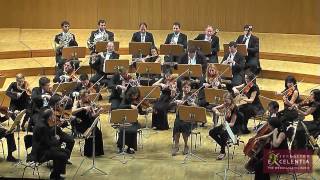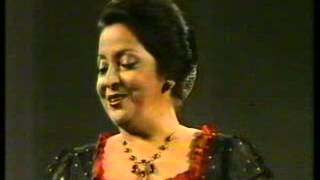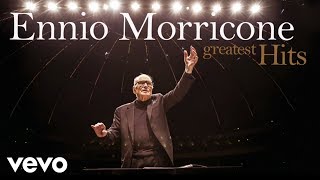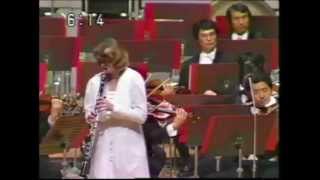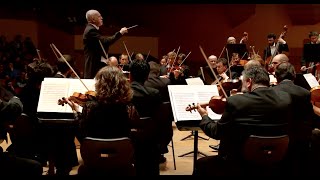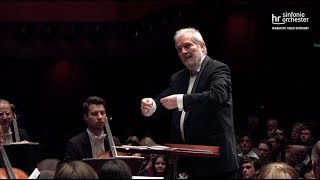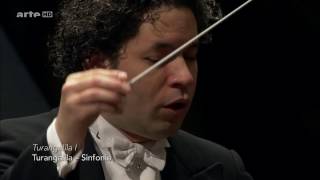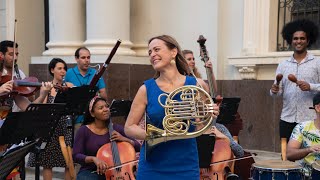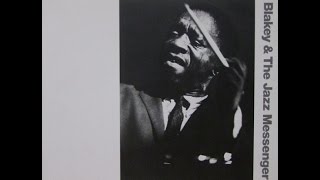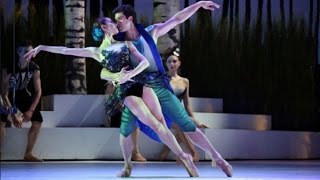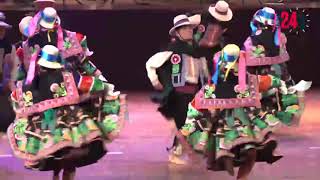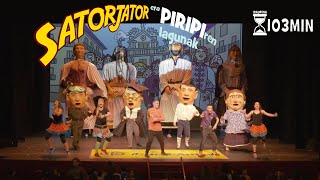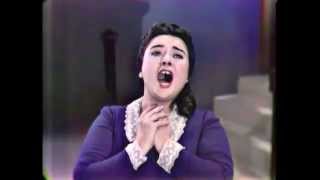January 27 is the Centenary of the Birth of Mozart and Arriaga
Recommended music videos for initiation to classical music
Wolfgang Amadeus Mozart (1756-1791) is considered one of the three giants of musical composition along with Bach and Beethoven . Child prodigy born in Salzburg , at the age of six he mastered the keyboard and the violin and began to compose. His father, Leopold exhibits him in exhausting tours of different European courts. A prolific composer (more than 600 works written from the age of five until his death), he cultivated all kinds of musical genres: piano works, chamber music, symphonies, concertante works, choral works, operas... each and every one of them, masterpieces of its gender. His operas The Magic Flute, Don Giovanni, Cosí fan Tutte, and The Marriage of Figaro are among the 10 most performed operas in the world. He died in Vienna at the age of 35.
The Piano Sonata No. 11 in A Major, k. 331 consists of three movements: I Andante with variations; II Minuet; III Rondo alla turca (popularly known as the “Turkish March of Mozart”). Today we will view the First Movement , which deals with a theme with variations (as it was frequently used in the French school at the time); its variations belong to the purest and most flexible type of the Mozartian style. Today's performance is given by the Chinese pianist Chingya Mahlen .
Juan Crisóstomo de Arriaga (1806 - 1826), known to many as the Basque Mozart , was born in Bilbao . His father, Juan Simón , came from Errigoiti , a town near Gernika where his mother, Maria Rosa , came from. His father, an organist from Berriatua , Bizkaia, moved to Bilbao to, like a good errigoitiarra, dedicate himself to the businesses with which he prospered and thus was able to promote the educational development of Juan Crisóstomo in Paris , where he would die 10 days before his 20th birthday. . His musical legacy, which has been preserved, consists of three string quartets, the Nada y mucho octet, written at the age of 11, the Overture No. 1 , the Symphony in D, several arias and cantatas as well as religious music such as O Salutaris . Hostia and Stabat Mater , as well as an opera, Los esclavos feliz , written at the age of thirteen of which only its overture is preserved, which we offer today in a performance by the Santa Cecilia Classical Orchestra conducted by the German maestro Florian Donderer .
Overture is the instrumental introduction to an opera or other dramatic work, musical or not, although some independent instrumental compositions of the 19th and 20th centuries were also called overtures by their composers. The first operas dating from the early seventeenth century , did not have overtures but an introduction made by the vocalists in which they made a summary of the action that was going to take place immediately afterwards. Instrumental introductions began to be used regularly in the mid- 17th century ; and the German composer Christoph Willibald Gluck was one of the first to use material from his operas for overtures. In this way, they established the emotional profile of the opera that followed.
Federico Chueca (1846-1908) was born in Madrid , in the Plaza de la Villa into a wealthy family; He received solfeggio classes from elementary school, which he attended at a select school, but his family forced him to abandon music to study medicine. Barbieri helped him orchestrate and conduct the works, and their great success convinced Chueca to leave medicine and dedicate himself to music. He is considered a self-taught musician with an innate talent and a knack for melody and rhythm, which led him to compose extraordinary pieces of music. He worked with several collaborators, but above all with Joaquín Valverde , in many of his works. He is currently considered one of the greatest representatives of the small genre (zarzuelas in one act).
La Gran Vía is a zarzuela in one act and five scenes with music by the maestros Federico Chueca and Joaquín Valverde and a libretto by Felipe Pérez y González premiered at the Felipe Theater in Madrid on July 2, 1886. It achieved such fame that they had to change some paintings, since being a current affairs magazine, it had to be modernized. This is how new paintings appeared, such as En la calle de Alcalá , or El bazaar de toyes . He is an exponent of the small genre taken to the field of the current affairs magazine, where the social and political concerns of the moment were exposed with good humor and a satirical sense. The script portrays with skill and satire, the news of the moment, showing on stage a great parade of types and comic situations of great effect.
Teresa Berganza Vargas (1933-2022) was a Spanish zarzuela and opera singer, frequently associated with characters from operas by Rossini, Mozart and Bizet , admired for her technique, musicality and stage presence. She studied piano and singing at the Madrid Conservatory , where she won first prize for singing in 1954. She made her debut in that city in 1955. Two years later she made her international debut at the Aix-en-Provence Festival . During the ten years Following she made her debut at La Scala , Glyndebourne festival, Royal Opera House , Metropolitan Opera House ... Her concert repertoire included Spanish, French, German and Russian songs. In 1994 she was elected a member of the San Fernando Royal Academy of Fine Arts , the first woman to obtain this distinction.
Ennio Morricone (1928-2020) was an Italian conductor and composer of more than 500 film and television soundtracks and other symphonic and choral compositions. From a musician father, as a child he began to study the trumpet and at the age of nine he entered the National Academy of Santa Cecilia . At the age of 18, he began writing for radio programs and, little by little, for movies. The film director Sergio Leone , a childhood friend, asked him to collaborate in his films and thus they created a different model of western, the Spagetti Western . His contracts were extended with other directors until he became one of the most appreciated soundtrack composers. Throughout his career he received important and innumerable awards endorsing his great work.
Today we present a collection of some of his best-known soundtracks conducted by Morricone himself. I (0:00) The Ecstasy of Gold (The Good, the Bad and the Ugly) .- . II (3:22) The Good, the Bad and the Ugly. -. III (6:04) Once upon a Time in the West .- . IV (9:15) For a Few Dollars More. -. V (13:05) A Fistful of Dynamite .-. VI (17:43) Cinema Paradiso - Main Theme .-. VII (20:13) Chi Mai (Maddalena & Le professionel) .-. VIII (23:48) . La Califfa - The Lady Caliph / The Queen .-. IX (26:27) My Name is Nobody .-. X (29:37) L'arena (Il Mercenario - The Mercenary / A Professional Gun) .-. XI (34:23) A Monument (I Crudeli – The Hellbenders) .-. XII (36:55) Misterioso e Ostinato (Faccia a Faccia - Face to Face) .-. XIII (39:17) Un Amico (Revolver) .-. XIV (41:55) Love Theme for Nata (Cinema Paradiso) .-. XV (46:03) Romanzo (1900 - Novecento) .-. XVI (50:12) Romance Quartiere (Quartiere) .-. XVII (53:51) Il Figlio e la Nostalgia (The Law of the Desert) .-. XVIII (57:41) Ninna Nanna per Adulteri (Cuore di Mamma) .-. XIX (01:00:45) Watch Chimes - Carillon's Theme (For a Few Dollars More) .-. XX (01:01:57) Primo Tradimento (Tepepa) .-. XXI (01:04:13) Run, Man, Run (The Big Gundown)
Recommended classical music videos
Mozart and Freemasonry . Freemasonry appeared in Europe at the end of the 17th century as a selective group of a philanthropic nature, with a federal structure and with humanistic objectives, such as the search for truth, the study of human behavior, science and the arts and the social and moral development of people and society; all this based on a feeling of brotherhood, whose teachings are symbolized with elements of masonry. At the age of 28, Mozart entered the Vienna Masonic Lodge as an apprentice ; the following month he was promoted to the rank of Companion and after four months he was appointed Master Mason . Influenced by the Enlightenment , he pursued rationalism, although without joining the occult character of many of his companions.
Wolfgang Amadeus Mozart 's Clarinet Concerto in A Major, K. 622 was composed in Vienna in 1791 for the clarinetist Anton Stadler , a great friend and fellow Freemason of Mozart 's. Unlike all other Mozart concertos , this one does not provide a cadenza for the soloist in its first movement , but in the second (15'44''-- 16'07''). On the other hand, it is composed, like all concertos for soloists of the time, of three movements . I (0´19´´) Allegro - Being the first movement it is in the key of the work: A major . II (12´20´´) Adagio - As established by the norm, this movement is in the subdominant tonality in relation to the main tonality of the work; i.e. D major . III (18´45´´) Rondó - In the same key as the first movement, A major.
Sabine Meyer (1959), today's soloist, is a German classical music clarinetist, who began playing the clarinet at a very young age. His first teacher was his father, also a clarinetist. She studied with Otto Hermann in Stuttgart , and then with Hans Deinzer at the Hannover Higher School of Music and Theater , together with her brother Wolfgang Meyer , and later husband, clarinetist Reiner Wehle , who later worked at the Munich Philharmonic. . She began her career as a member of the Bavarian Radio Symphony Orchestra , and the Berlin Philharmonic Orchestra , where she was one of the first female members. In addition to her solo work, Sabine Meyer is a committed chamber music performer.
Symphony . The word derives from the Latin symphonĭa meaning consonance as opposed to diaphōnia meaning dissonance. In the Middle Ages the word symphony was used to describe instruments capable of producing more than one sound simultaneously and by the end of the 18th century the word had already acquired its current meaning: a work for orchestra consisting of several sections. The symphony reached its maturity with Beethoven . His symphonies used to have a first movement “Allegro” in sonata form , a slow second movement (sometimes in theme and variations form), a third movement with ternary rhythm (usually a scherzo , before Beethoven the common was a minuet and trio ). ), ending with the rapid fourth movement in the form of a rondo or sonata .
The Symphony in D minor , which we offer today, is one of the most paradigmatic and representative works of the artistic legacy of Juan Crisóstomo de Arriaga . Although the exact year of its composition is not known with certainty, it is framed around 1824, at which time Arriaga was in full swing in Paris. As for the main key in which the symphony is composed, there are also doubts; although following a reading by Víctor Estapé and Aurelio M. Seco , the symphony is in the key of D minor , although the introduction in D major may mislead. The symphony is structured in four movements: I (0´30´´) ADAGIO. ALLEGRO VIVACE (3´39´´) .-. II (10´25´´) WALKING .-. III (18´50´´) MENUETTO: ALLEGRO .-. IV (23´05´´) ALLEGRO WITH MOTORCYCLE.
Today's interpretation is offered to us by Jesús López Cobos (1940-2018), a Spanish conductor who had his first contacts with music as a member of the choir of the Cathedral of Malaga ; His first studies were carried out at the Madrid Conservatory to continue them in Germany and New York . Throughout his career he was director of the Berlin Opera , of the Cincinnati Symphony Orchestra , of the Lausanne Chamber Orchestra and musical director of the Teatro Real in Madrid ; he directed different operas at La Scala in Milan , at Covent Garden in London , at the Paris Opera House and at the Metropolitan in New York ; as a guest conductor, he conducted the world's leading orchestras.
Max Reger (1873-1916), was a German composer, organist, pianist, and teacher born in Brand , Bavaria. He studied music in Munich and Wiesbaden under Hugo Riemann . During a creative life of just over 20 years, Reger produced a large number of works for organ and other genres (with the exception of opera). He was a strong champion of absolute music, and saw himself as part of the musical tradition of Ludwig van Beethoven and Johannes Brahms . His work often combines the classical structures of these composers with the extended harmonies of Franz Liszt and Richard Wagner and the complex counterpoint of Johann Sebastian Bach . Of his orchestral works, the Hiller Variations and the Mozart Variations , which we offer today , are the most remembered.
The Variations and Fugue on a Theme by Mozart , Op. 132, is a set of variations for orchestra composed in 1914 by Max Reger ; the composer conducted the premiere in Berlin on February 5, 1915. The composition is structured in the following movements: I (0´04´´) THEME: ANDANTE GRAZIOSO .-. II (2´44´´) VARIATION 1ª: L'ISTESSO TEMPO, QUASI UN LITTLE PIÙ LENTO .-. III (5´17´´) 2nd VARIATION: LITTLE AGITATO .-. IV (7´34´´) 3rd VARIATION: WITH MOTORCYCLE .-. V (9´09´´) VARIATION 4ª: VIVACE .-. VI (10´00´´) VARIATION 5ª: QUASI PRESTO .-. VII (11´49´´) VARIATION 6ª: SOSTENUTO (QUASI ADAGIETTO) .-. VIII (13´59´´) VARIATION 7ª: ANDANTE GRAZIOSO .-. IX (16´51´´) VARIATION 8ª: MOLTO SOSTENUTO .-. X (23´52´´) FUGA: ALLEGRETTO GRAZIOSO.
The version that we offer today is conducted by Péter Eötvös (1944), a Hungarian composer and conductor, who has held at different times the ownership of the direction of the Stockhausen Ensemble , the Ensemble InterContemporain of Paris , the Radio Chamber Orchestra of Hilversum , as well as he has been Principal Guest Conductor of the BBC Symphony Orchestra , of the Budapest Festival Orchestra , of the National Philharmonic, also of Budapest, of the Stuttgart Radio Symphony Orchestra, of the Symphony Orchestra of Vienna ... and has conducted other important orchestras on different occasions such as the Royal Concertgebouw Orchestra, the Cleveland Orchestra, the Berlin Philharmonic Orchestra or the Vienna Philharmonic Orchestra .
Olivier Messiaen (1908-1992) was a French composer, organist, educator and ornithologist, one of the most outstanding musicians of the entire century. His fascination for Hinduism, his admiration for nature and birds, his deep Christian faith and his love for instrumental color were essential for his formation as a person and artist. He entered the Paris Conservatoire at the age of 11, and was taught by Paul Dukas, Marcel Dupré, Maurice Emmanuel and Charles-Marie Widor . He was appointed organist at the Church of the Holy Trinity in Paris in 1931, a position he held until his death. In 1941 he was appointed professor of harmony, and in 1966, professor of composition at the Paris Conservatoire , a post he held until his retirement in 1978.
The Turangalila Symphony , a work of great proportions structured in 10 movements interlinked by a series of themes and musical ideas that reappear over and over again, resembles a concerto for piano and ondas Martenot ... It requires 103 musicians with a very wide range of percussion and keyboards and its duration is about 80'. Olivier Messiaen composed it for a commission by the Boston Symphony Orchestra and the work is considered one of the masterpieces of 20th century classical music. In the words of the author "The title comes from the two Sanskrit words, turanga and lila , and can be freely translated as 'love song and hymn to joy, time, movement, rhythm, life and death."
The version that we are presenting today is performed by La Orchester philharmonique de Radio France conducted by Susanna Mälkki with Roger Muraro on piano and Cynthia Millar on Ondes Martenot.
Recommended music videos for all tastes
Mambo is a musical rhythm and dance native to Cuba . The word “ mambo ” is an Afronegrism, similarly to other African-American musical terms such as conga, milonga, bomba, tumba, samba, bamba, bambulá, tambo, tango, cumbé, cumbia, and candombe , which denote an African origin, and particularly congolese The original roots of the Mambo , which can be found in the “ Danzón de Nuevo Ritmo ”, was popularized by the Arcaño y sus Maravillas orchestra by accelerating the danzón and introducing a syncopation on the percussion. It was Arcaño's cellist, Orestes López , who created the first Danzón called Mambo in 1938.
Sarah Willis (1969) is an American horn player who grew up in Maryland, Tokyo, Boston, Moscow, and London . He began playing the French horn at the age of 14; at 22, he entered the Berlin State Opera and at 32, at the Berlin Philharmonic where he continues to this day. In 2017, she traveled to Cuba for the first time to give a master class on horn, at which point she fell in love with the overflowing musicality of its inhabitants and the high technical preparation of its musicians; He returns three more times to give as many master classes; Mozart and Mambo emerges from this coexistence with Cuban musicians, which is a musical selection that combines concerts for Mozart 's horn with traditional Cuban music. The album was published in 2020 and the Little Night Serenade also appears on it in a mambo version.
And from the record, to the performance: Rondó alla Mambo! Inspired by the third movement of the third horn concerto K. 447 is a flashmob (unusual performance by a group of people who appear and disappear suddenly) written by Joshua Davis and Yuniet Lombida Prieto that makes its appearance on the streets of Havana; the flashmob is interpreted by Sarah Willis and members of the Lyceum Orchestra of Havana as a climax to the experience of " Mozart and Mambo ".
The Jazz Messengers were a jazz combo that existed for over thirty-five years, ending when founding leader and drummer Art Blakey died in 1990. Blakey managed or co-managed the group from the beginning. "Art Blakey" and "Jazz Messengers" became synonymous over the years, though Blakey conducted non- Messenger recording sessions and played sideman for other groups throughout his career. The group became a testing ground for young jazz talent. While veterans occasionally reappeared in the group, in general, each Messenger interaction included a lineup of new, young performers. Having the Messengers on your resume was a rite of passage into the world of jazz and conveyed immediate bona fides.
Camarón de la Isla (1950-1992) was born on Carmen street, located in the neighborhood popularly known as "Las Callejuelas" in the Cadiz town of San Fernando . Considered one of the best singers of all time, it is his personal heritage to have revolutionized an art that was dying, starting from the most intimate character of flamenco, despite the criticism received. On his records he brought flamenco closer to profane ears as well as working on musical mixes, while in his more intimate recitals he showed a more sober and intimate character. In 2000, he was posthumously awarded the Llave de Oro del Cante .
Beyoncé (1981) is an American actress, songwriter and singer who became famous as the singer of the female group Destiny's Child , which was one of the female groups in history that has sold the most records. After separating from the group, a new phase begins in which she calls herself a contemporary feminist . As a solo singer, he made his debut with the album Dangerously in Love. for his eponymous song with which he won five Grammy Awards . In 2010 her third album I Am...Sasha Fierce , which we offer today, received six Grammy Awards . In 2016 his album is the most sold worldwide. Throughout her 20-year career, she has won 24 Grammy Awards and is currently considered one of the best singers in popular music.
Recommended peculiar videos
Il Giardino degli Amanti . It is a suite created by the Roman choreographer Massimiliano Volpini with fractions of Mozart 's compositions in which different characters from his works appear, dancing to the mysterious and intimate music to which they are invited.
Roberto Bolle (1975) is an Italian classical ballet dancer who has performed with the most renowned ballet companies in the world. In 2003 she received the title of étoile from La Scala Theater and in 2009 principal dancer from the American Ballet Theatre . Likewise, Nicoletta Manni (1991) is the prima ballerina of the Teatro La Scala Ballet.
Jacques Offenbach (1819-1880) was a French cellist and composer of German origin who converted to Catholicism in order to marry the Catholic Herminia de Alcain . He began his musical studies with his father, a music teacher; at the age of 14 his family moved to Paris where he continued his studies with Cherubini . In 1855 he founded the Bouffes Parisiens theater, where he staged his own plays, which reflect the joie de vivre of his time. It also presented amusing adaptations by other musical geniuses such as G. Rossini . His German ancestry made him enemies after the Franco-Prussian War; enemies that he reflected with irony representing them in his operettas. The greatest exponent of French operetta (he wrote hundreds of them), his remains rest in the Montmartre cemetery.
Orpheus in the Underworld is an operetta in four acts with music by Jacques Offenbach and a French libretto by Hector Crémieux and Ludovic Halévy . It is said to be the first long operetta; it was also the first time that Offenbach had used Greek mythology as a backdrop for one of his slapsticks. The work refers to the myth of the poet and musician Orpheus and his wife, Eurydice , the oldest love myth in classical Greece and culminates in the infernal gallop , which we offer today; bawdy gallop that astonished part of the audience at the premiere and famous outside classical circles as the music of the "can-can"; It is the dance that the gods dance at the end of the opera until they drop dead. Today we see it performed by the German company Fernsehballet .
The International Cervantino Festival (FIC), popularly known as "El Cervantino", has been held since 1972 in the city of Guanajuato , in the Mexican Bajío region. The festival was born in the mid- 20th century when the hors d'oeuvres by Miguel de Cervantes were still performed in the squares of various Guanajuato cities, staged by maestro Enrique Ruelas Espinosa . In the 1970s more artistic activities were added to the traditional performances to reinforce the international dimension of the festival. Since then it has grown to become one of the four largest festivals of its kind in the world.
The National Folklore Cast of Peru offers us today some of the most representative pieces of Peruvian music and dance within this international folklore show held in Mexico .
Călușarii . This dance dates back to ancient times when instead of Romania and the Republic of Moldova there was the former Kingdom of Dacia . The dance is traditionally performed, in the week before Pentecost , but there are documents that testify to the practice of the dance on other occasions, such as the dance performed by the soldiers of Michael the Brave , "calușerii", who were under the leadership of the captain Baba Novac , during the celebration given by Sigismund Bathory in 1599, in Piatra Caprei , near Alba Iulia . Calus is a Romanian custom practiced during the Pentecost period. Similar traditions exist throughout the European expanse of the ancient Roman Empire , from the Moorish Dance in Great Britain or the Pauliteiros in Portugal .
Recommended music videos for children
Various Wikipedia articles have been used to write these texts.
The texts of Videomusicalis are written in Basque, Spanish and English.





